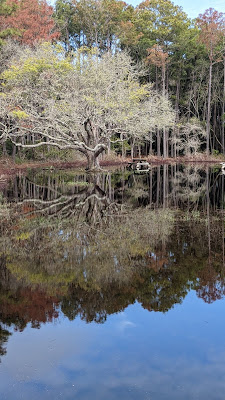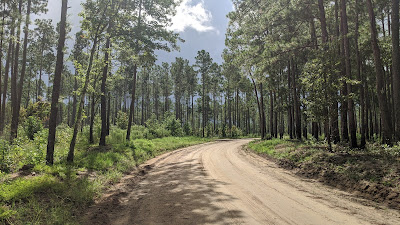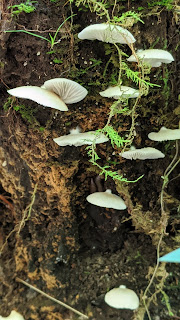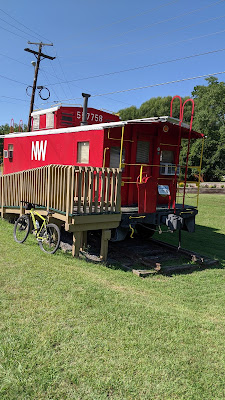- Date Biked: September 11 and 12, 2020
- Total miles Tracked: 8.75 and 9.78
- Type of Trail: Dirt roads (and we'll define the word "road" loosely here)
- Conveniences: There's a sign at the entrance. What more do you want?
- Best Features: Unique ecosystems, isolation
- Worst Features: Bugs and bogs
- Wildlife spotted: A frog. But we did see lots of tracks!
- Vegetation: Pines and pitcher plants (theoretically Venus Flytraps)
- Associated Website:https://www2.dnr.sc.gov/ManagedLands/ManagedLand/ManagedLand/104
- Primary Author: James


This is a bit different from most of our biking posts, which focus on greenways and rail trails. This time, we're biking on dirt roads open to motor vehicles as well. To find places to bike, I spend a lot of time on Google Earth. The last time we went to South Carolina, I was looking for someplace new to bike, and I noticed a big swath of empty green space just north of Myrtle Beach. One one side of the Carolina Bays Parkway, housing and businesses are densely packed all the way down to the ocean. On the other side of the parkway, there's open land full of big oval depressions that look like shallow impact craters. These are the eponymous "Carolina Bays." The bays house delicate ecosystems. You find a lot of carnivorous plants in them, and the preserve is the last place in South Carolina where you can still find Venus flytraps growing wild. Lewis Ocean Bay Heritage Preserve was created to protect this unique landscape.


The preserve is open to the public, but it's interesting how many people we've talked to in Myrtle Beach who seemed unaware it exists. In fairness, there's not much to do here. There are no picnic tables or restrooms, and the landscape is flat, monotonous pine forest for as far as the eye can see. The preserve is theoretically home to black bears, racoons, eagles, and other wildlife, but the main wildlife you're guaranteed to encounter will be biting flies. We did find quite a few footprints in the sand, however.
 |
Frogs count as wildlife!
|
 |
Spiders too!
|
So, if you go there looking for a fun in the sun beach-like experience, you'll likely be disappointed. But, if you go with an open mind and a sharp eye, you'll find the visit rewarding. While we never located any Venus flytraps, we didn't have to look too hard to find carnivorous pitcher plants. Since we were searching for flytraps, we were paying close attention to even tiny changes in the forest floor. If you were moving along the dirt roads in a car, the landscape would probably all look the same. But on a bike, you see how the slightest changes in the soil produces a variety of ecosystems where different plants dominate only yards from each other. We found a great variety of wildflowers, and imagine that a springtime visit would bring an even greater bounty.









We visited two days and rode roughly 9 miles each day. We could easily have logged more miles without much effort if we hadn't been stopping every half mile for photos. The preserve map doesn't list distances, but I'm guessing there's easily 25 miles or so of roads and trails that could be biked. While the roads are level and smooth, you'll need a bike with fat tires to handle the patches of soft sand and mud. Despite my earlier crack about biting flies, this wasn't the worst landscape we've ever ridden through in terms of bugs. Honestly, 90% of our ride was bug free, but when you did hit patches of insects in some of the swampier areas, they were pretty aggressive. And, speaking of swampier areas, we went down a road called Flytrap Lane thinking it would be a short cut back to the parking lot, only to find ourselves knee deep in muck. We kept looking at Google maps and thinking, "If we make it through this, the paved road has to be just around the corner." After the fifth bog we waded through, that turned out to be correct! Alas, we didn't see any flytraps on Flytrap lane, probably because we were too busy groping around in the muck trying to find Cheryl's lost shoe. Adventure!


 |
Adventure!
|
As for the bays themselves, from the ground it's hard to tell when you're passing through one or riding right beside one. Some of them have sandy outer rims that are easy to spot, and riding along the rim of another the vegetation was so thick and dense along the rim you'd need a machete to see what was behind it.
 |
The outer rim of a Carolina Bay
|
Aside from the amazing ecosystems, the best reason to come ride here is the isolation you'll experience. Once you get a mile or two from the entry gate on International Drive, the silence is profound. While we did encounter a few cars driving through the preserve, most of the time we were biking we were utterly alone. We'll happily leave the crowded beaches and bustling shopping centers in Myrtle Beach to others to explore even more of this wild space.

































































